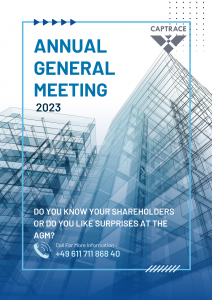Do you know your shareholders or do you like surprises at the AGM?
SRD II facilitates shareholder identification.
A chore or a unique opportunity for dialogue with shareholders – the approach to the AGM is as varied as the range of listed companies. What they all have in common is the need for extremely thorough preparation of the annual shareholders‘ meeting. A precise analysis of the shareholder structure is the basis for this. Thanks to the Shareholder Rights Directive II, this can now be done much more quickly and cheaply.
For most listed companies with bearer shares, the annual general meeting used to be the only opportunity in the year to get in touch with all their shareholders. However, in the past this was only done indirectly, via the custodian banks. They only found out who actually owned the company’s shares when the shareholders responded to the invitation and registered for the AGM or cast their votes. Depending on attendance, a more or less vague picture of the ownership structure emerged.
Those who wanted to know at other times or more precisely had to conduct a shareholder survey or „Share ID“. So far, the results were often not really satisfactory. The information was usually slow in coming in, if it came in at all. There was neither an obligation for banks to respond nor a requirement to do so within a certain time. The effort was high for all involved, as were the costs. The result, however, was only meaningful to a limited extent – simply due to the fact that the data collection could be spread over several weeks. Apart from the names of institutional shareholders and the number of shares they hold, not much could be learned.
So it is hardly surprising that few companies in this country conducted a regular survey. Those who commissioned a „Share ID“ usually had a special reason. Such an occasion is typically the upcoming AGM – i.e. the very event at which information about shareholders is received anyway. Why? Because in the case of critical AGM resolutions, important shareholders are to be picked up in advance and majorities are to be organised. In this case, it makes sense to prepare the ground in advance of the publication of the agenda. The companies that will hold their shareholders‘ meeting in the second quarter of 2023 are now exactly in this phase.
Governance roadshows – the answer to the trend towards increasing investor influence
But it is not only critical or activist investors who demand a more intensive dialogue. More and more institutional investors are focusing on the aspects of their investments that go beyond monetary returns. This has led to an increasing number of votes on important governance issues. Recently, there has also been an increase in influencing board elections or investors initiating discussions on environmental impact, sustainable business practices or diversity.
As institutional investors seek a more active „stewardship role“, IR departments should also be more attuned to the governance experts among their investors. This is definitely a new direction; in the past, IR teams focused almost exclusively on the portfolio managers and analysts who made the buy/sell decisions. Intensive engagement with their own shareholder base and knowledge of their objectives in terms of environmental, social and governance („ESG“) aspects is the basis. In turn, knowledge of the shareholder structure is a prerequisite for this.
Faster and cheaper access to better data
The regulations of the Shareholder Rights Directive II (SRD II), which came into force at the beginning of September 2020, now create completely new prerequisites for shareholder surveys – but so far only for issuers listed in regulated markets. For them, the simple formula now applies: Faster, cheaper and better data. All parties involved are obliged to forward information electronically under strict time limits – usually on the same day. As a result, the processing time has been halved from six to eight weeks in the past to two to three weeks now. A further reduction to one to two weeks is the goal. Disclosure rates of 95 to 99 percent of the capital will be achieved. The new regulation also covers financial intermediaries based outside the EU, e.g. Switzerland, Liechtenstein or the USA, if they hold shares of affected companies in custody for their clients.
The effort required has also been significantly reduced compared to the manual collection of data as in pre-SRD II times – and thus also the costs, by at least half. This is good, because companies can now afford to have their shareholders surveyed at shorter intervals, which makes the data more meaningful through status comparisons.
In addition to the names of their investors and information on their holdings, issuers now also receive the complete address, and in the case of private investors even the date of birth, if applicable. From institutional custodians, the issuer learns the Legal Entity Identifier designation and can thus allocate the holdings down to individual funds. This opens up new perspectives for IR work and enables more intensive communication, whether with fund managers or private investors. And there are said to be companies that don’t see the AGM as an annoying compulsory event, but organise it as an event that involves the shareholders in the company’s development in order to bind them to the company.
Götz Dickert, Managing Director Captrace GmbH
CAPTRACE is funded by the State of Hessen/Germany

